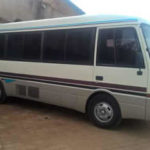Uganda is a very beautiful and touristic country whose infrastructures, including roads, are greatly improved. Most roads in the major urban cities and towns are tarmac and all in a fine condition.
In the remote areas, where Uganda’s most touristic destinations are perched, most of the roads are muddy and with this reason you are highly emphasized to hire a 4X4 vehicle.
During the rainy season, the muddy roads become slippery and difficult to drive onto, especially when you have a 2WD vehicle. Therefore, it is better you plan your Ugandan trip in a dry/sunny season – June to October and then January to early March. Meanwhile, below are some of the most vital road laws in Uganda:
-Keep left; we all know that earth consists of very many countries with different rules and laws governing each country. When it comes to driving, some countries drive on the left hand side of the road well as others do the opposite. For the case of Uganda, you will have to drive on the left hand side of the road (keep left).
Therefore if you are coming from a country that keeps right, you should start bearing it in mind that on your Ugandan trip you will drive on the left hand side or else hire a professional driver-guide from any sanctioned travel agency in Uganda.
-Follow all the road signs you pass-by; many drivers have a tendency of ignoring some sign posts when driving. If you dare behave in this way, be ready to face all the consequences. Traffic lights are sets of red, amber, and green lights at the places where roads meet. They control the traffic by signaling when vehicles have to stop and when they can go. Don’t dare drive when the lights are red not until they turn green.
-Over speeding and loading leads to penalties; on highways, like the Entebbe-Kampala express road, you can drive up to 100km/hr but don’t drive this speed anywhere else unless when you meet a sign that gives you a go ahead to drive 100km/hr. Meanwhile, the speed limit in Uganda is 80km/hr and in remote areas try to slow it to at most 60km/hr. When it comes to driving in the national parks, you will have to drive an at most speed of 40km/hr.
-Carry your valid driving permit; whenever you sit on the steering of your car, first cross check – thoroughly if you carried your driving permit and make sure it’s valid and it has been in use for over 12 months. Don’t ever risk driving a car when you lack a driving permit as this will cause many problems for you.
-Tie the sitting belt before you set forth; a sitting belt is seen as something not important by many drivers yet it’s very vital! By tying your sitting belt when driving, you are saving your own life somehow. Please, tie the sitting belt before you begin any journey as even the traffic officers will charge you when found with a sitting belt untied.
About Fuel
Most vehicles provided by the car hire companies are of either petrol or diesel. Therefore, make sure you know which type of fuel your vehicle consumes before you head any further.
Fuel is filled only from the petrol stations and you are advised to fill up your vehicle before heading to the national parks. In the Parks there are no petrol stations and if you dare go with an unfilled vehicle, you will get upsets on your trip.































